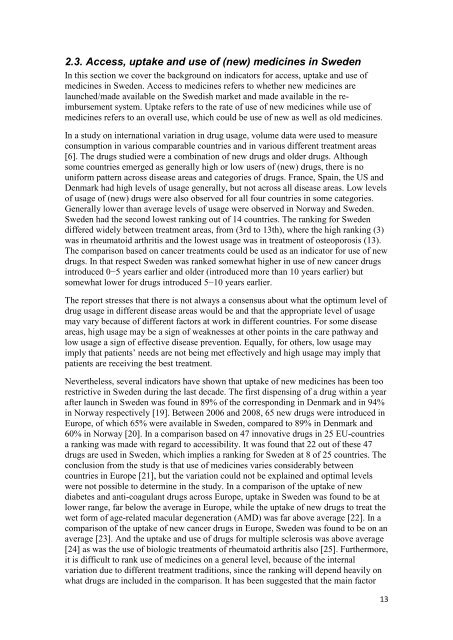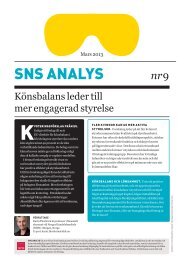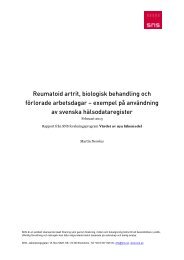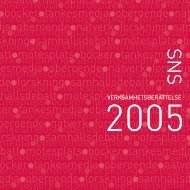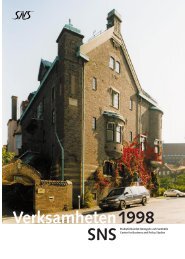Billie Pettersson and Frank R. Lichtenberg - SNS
Billie Pettersson and Frank R. Lichtenberg - SNS
Billie Pettersson and Frank R. Lichtenberg - SNS
You also want an ePaper? Increase the reach of your titles
YUMPU automatically turns print PDFs into web optimized ePapers that Google loves.
2.3. Access, uptake <strong>and</strong> use of (new) medicines in SwedenIn this section we cover the background on indicators for access, uptake <strong>and</strong> use ofmedicines in Sweden. Access to medicines refers to whether new medicines arelaunched/made available on the Swedish market <strong>and</strong> made available in the reimbursementsystem. Uptake refers to the rate of use of new medicines while use ofmedicines refers to an overall use, which could be use of new as well as old medicines.In a study on international variation in drug usage, volume data were used to measureconsumption in various comparable countries <strong>and</strong> in various different treatment areas[6]. The drugs studied were a combination of new drugs <strong>and</strong> older drugs. Althoughsome countries emerged as generally high or low users of (new) drugs, there is nouniform pattern across disease areas <strong>and</strong> categories of drugs. France, Spain, the US <strong>and</strong>Denmark had high levels of usage generally, but not across all disease areas. Low levelsof usage of (new) drugs were also observed for all four countries in some categories.Generally lower than average levels of usage were observed in Norway <strong>and</strong> Sweden.Sweden had the second lowest ranking out of 14 countries. The ranking for Swedendiffered widely between treatment areas, from (3rd to 13th), where the high ranking (3)was in rheumatoid arthritis <strong>and</strong> the lowest usage was in treatment of osteoporosis (13).The comparison based on cancer treatments could be used as an indicator for use of newdrugs. In that respect Sweden was ranked somewhat higher in use of new cancer drugsintroduced 0−5 years earlier <strong>and</strong> older (introduced more than 10 years earlier) butsomewhat lower for drugs introduced 5−10 years earlier.The report stresses that there is not always a consensus about what the optimum level ofdrug usage in different disease areas would be <strong>and</strong> that the appropriate level of usagemay vary because of different factors at work in different countries. For some diseaseareas, high usage may be a sign of weaknesses at other points in the care pathway <strong>and</strong>low usage a sign of effective disease prevention. Equally, for others, low usage mayimply that patients’ needs are not being met effectively <strong>and</strong> high usage may imply thatpatients are receiving the best treatment.Nevertheless, several indicators have shown that uptake of new medicines has been toorestrictive in Sweden during the last decade. The first dispensing of a drug within a yearafter launch in Sweden was found in 89% of the corresponding in Denmark <strong>and</strong> in 94%in Norway respectively [19]. Between 2006 <strong>and</strong> 2008, 65 new drugs were introduced inEurope, of which 65% were available in Sweden, compared to 89% in Denmark <strong>and</strong>60% in Norway [20]. In a comparison based on 47 innovative drugs in 25 EU-countriesa ranking was made with regard to accessibility. It was found that 22 out of these 47drugs are used in Sweden, which implies a ranking for Sweden at 8 of 25 countries. Theconclusion from the study is that use of medicines varies considerably betweencountries in Europe [21], but the variation could not be explained <strong>and</strong> optimal levelswere not possible to determine in the study. In a comparison of the uptake of newdiabetes <strong>and</strong> anti-coagulant drugs across Europe, uptake in Sweden was found to be atlower range, far below the average in Europe, while the uptake of new drugs to treat thewet form of age-related macular degeneration (AMD) was far above average [22]. In acomparison of the uptake of new cancer drugs in Europe, Sweden was found to be on anaverage [23]. And the uptake <strong>and</strong> use of drugs for multiple sclerosis was above average[24] as was the use of biologic treatments of rheumatoid arthritis also [25]. Furthermore,it is difficult to rank use of medicines on a general level, because of the internalvariation due to different treatment traditions, since the ranking will depend heavily onwhat drugs are included in the comparison. It has been suggested that the main factor13


